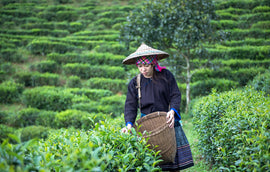Tea, a beverage steeped in history and tradition, has been a symbol of unity and a harbinger of tranquility across civilizations. Over time, the art of blending tea has evolved, inviting tea enthusiasts to explore a kaleidoscope of flavors, aromas, and experiences. Let’s embark on a journey to unravel the meticulous and creative process of blending tea and discover how it crafts harmony in a cup.
1. Exploring the Canvas: Types of Teas
Blending tea begins with a profound understanding of the myriad types of teas available. From the robustness of black tea, the subtlety of green tea, to the exoticism of oolong and the purity of white tea, each variant offers a unique canvas for crafting blends. The diversity in tea types lays the foundation for endless possibilities in flavor combinations and profiles.
2. Selecting Ingredients: Crafting the Palette
Tea blending is akin to painting, where the ingredients represent different hues on a palette. Apart from tea leaves, a plethora of ingredients such as herbs, spices, flowers, fruits, and essential oils are used. Ingredients like chamomile, peppermint, ginger, and bergamot add layers of flavor, aroma, and therapeutic benefits, enhancing the overall tea experience.
3. Balancing Flavours: Creating Symphonies
Blending tea is an intricate dance of balancing flavors and aromas to create a harmonious symphony. The mastery lies in understanding the characteristics of each ingredient and how they complement or contrast with one another. The objective is to achieve a blend where no single flavor dominates, but rather, each component contributes to a well-rounded and cohesive taste profile.
4. Trial and Tasting: Perfecting the Blend
Once the components are chosen, the blending process entails meticulous trials and tastings. The proportions of tea leaves and additional ingredients are adjusted, and brewing times are experimented with, to perfect the flavour, aroma, and appearance of the blend. This phase is crucial, as it transforms the theoretical concept of the blend into a tangible and enjoyable reality.
5. Customization: Crafting Personal Experiences
Blended teas offer a personalized and explorative experience for tea enthusiasts. Customization allows for the creation of signature blends, catering to individual preferences, dietary needs, and even moods. From a refreshing citrus blend for a sunny morning to a soothing lavender-infused concoction for a restful night, the possibilities are endless and immensely personal.
6. Packaging and Preservation: Safeguarding the Symphony
Preserving the integrity of the blended tea is essential. The packaging process involves safeguarding the tea from external elements such as light, air, and moisture, which could compromise its flavour and freshness. Sustainable packaging options are gaining popularity, aligning with the growing consciousness towards environmental conservation.
7. Sustainability and Ethical Sourcing: A Conscious Blend
The art of blending tea extends beyond flavour profiles to encompass ethical and sustainable practices. Ethical sourcing of tea leaves and ingredients, fair trade practices, and organic farming are integral to creating blends that are not only delightful but also conscientious and responsible.
Conclusion
The craft of blending tea is a harmonious interplay of art and science, tradition and innovation. It invites us to explore the infinite possibilities that arise from combining diverse flavours, aromas, and textures. As we savor the symphonies crafted through blending tea, we are also reminded of the importance of sustainability, ethical sourcing, and customization in enhancing the tea experience. In every sip of a blended tea, we find a harmonious connection to nature, culture, and our inner selves, making the tea journey truly enchanting.
I bought some “Long Distance” loose leaf tea at Milner Gardens & Woodland gift shop and it does not have any instructions on how long to steep it?? Can you send me directions please.






Comments